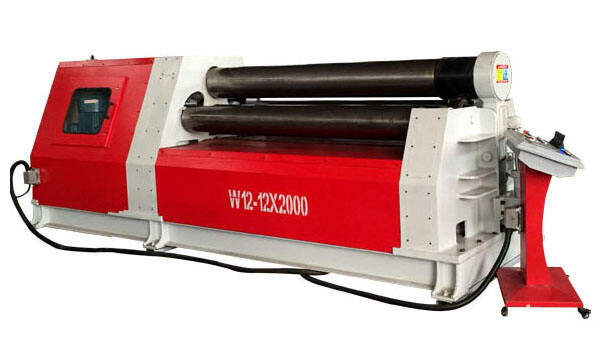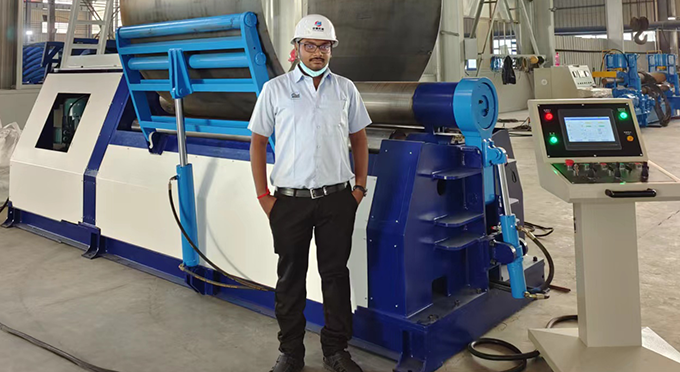Understanding Sheet Rolling Machine Fundamentals
Key Components of Modern Sheet Rolling Systems
Modern sheet rolling machines are designed with precision and efficiency in mind. The main components of these systems include rollers, frames, and hydraulic systems. Rollers, typically made of hardened steel or alloy, are crucial for transforming flat sheets into their desired shapes. Frames provide the necessary stability and support, ensuring the machine withstands the considerable forces exerted during the rolling process. Hydraulic systems, integral to the machine's function, enable precise control over the rolling pressure and position of the rollers. Each component plays a vital role in the successful operation of a sheet rolling machine, ensuring that materials are processed efficiently and to exact specifications. To ensure durability and performance, most of these components are constructed from high-strength materials capable of withstanding repeated use and high stress.
Thin Metal vs. Plate Processing Differences
The processes involved in rolling thin metal sheets and thicker plates differ significantly due to the nature of the materials. While thin metal processing primarily focuses on maintaining the integrity of the material and preventing warping or deformation, plate processing demands overcoming the material's inherent strength to achieve the desired shape. This challenge is addressed through machinery specifically designed for the thickness of the material. For thin metals, technologies like adjustable roller gaps ensure uniform pressure and prevent warping. In contrast, processing thicker plates often involves using powerful hydraulic systems to generate the necessary force. Understanding these differences can help in choosing the right machinery and techniques, such as a hydraulic plate bending machine for thicker materials, thereby optimizing efficiency and ensuring high-quality finished products.
Core Principles of Thin Metal Rolling Technology
Material Compression Dynamics
In the realm of thin metal rolling technology, the dynamics of material compression are crucial for determining the success of the process. The key mechanical principle involved is the consistent application of pressure across the metal's surface which helps prevent common defects like warping or uneven thickness. According to studies published in industry journals, achieving uniform compression significantly affects the quality of the rolled metal, reducing defects and enhancing the material's structural integrity. This process involves the careful adjustment of roller spacing and pressure settings on sheet rolling machines that specialize in handling lightweight materials.
Tolerance Control in Precision Forming
Achieving tight tolerances in metal forming is a challenge that requires advanced methods and technologies. Precision forming demands meticulous control over dimensions, ensuring minimal deviation from specified measurements. Industry standards dictate that tolerance levels should be within a specified narrow range to maintain quality, especially in applications like aerospace and automotive manufacturing. Technologies such as digital measurement tools have revolutionized this area, providing real-time monitoring and feedback to achieve precision. For example, electronic displays on modern sheet rolling machines offer operators instant feedback, helping ensure that the process remains within specified tolerances.
Role of Hydraulic Systems in Bending Accuracy
Hydraulic systems play a pivotal role in ensuring bending accuracy for sheet metal rolling operations. These systems enable the precise control of bending forces, a critical factor when working with thin metals prone to deformation. Hydraulic press brake machines, commonly used in metal forming, incorporate advanced hydraulic systems that contribute to improved performance. Notably, statistics show that these machines enhance efficiency by achieving consistent bends and maintaining high accuracy levels across large production runs. This technological advancement underscores the importance of hydraulic systems in achieving desired shapes and reducing manual adjustments during the bending process.
Types of Sheet Rolling Equipment
Understanding the different configurations and functionalities of sheet rolling equipment is vital for selecting the right machine for specific applications. Let's explore the various types of rolling equipment commonly used in the metal fabrication industry.
Two-Roll vs. Three-Roll Configurations
The choice between two-roll and three-roll configurations largely depends on the specific needs of a project. Two-roll machines are primarily suited for operations involving large-series production of thin sheet metal, offering simplicity and ease of use. On the other hand, three-roll machines are versatile, often utilized for mid-range size projects involving metal thicknesses up to an inch. They provide greater flexibility in forming cylindrical shapes. A case study involving a metal fabrication plant showed enhanced efficiency and precision with three-roll configurations in manufacturing automotive components. They were able to improve production speed by 20% compared to two-roll setups, demonstrating their practical advantages.
Four-Cylinder Heavy Duty Plate Rollers
In industrial applications, four-cylinder heavy-duty plate rollers stand out due to their ability to handle challenging materials and considerable thicknesses. Their design incorporates a Double Pinch mechanism, ensuring superior precision and reliability. These rollers are particularly praised for their high rolling speed and capability to maintain material integrity during bending processes. Testimonials from operators in industries such as shipbuilding and heavy machinery manufacturing highlight the machine's robustness and efficiency. One operator noted a significant reduction in material slipping and improved accuracy, thus enhancing productivity.
CNC-Enhanced Hydraulic Bending Machines
The integration of CNC technology with hydraulic bending machines signifies a leap in precision metal forming. CNC systems provide unparalleled automation benefits, enabling accurate bends and consistent production. This enhancement results in significant productivity increases and cost reductions across various sectors. A survey conducted in the automotive industry indicated a remarkable 25% improvement in manufacturing efficiency year-over-year, following the adoption of CNC-equipped machines. These findings underscore the transformative potential of this technology in optimizing production processes.
Overall, understanding these categories helps to strategically select rolling equipment based on the unique requirements of different metalworking tasks. Leveraging these technologies can result in substantial gains in operational effectiveness and product quality.
Optimizing Precision in Metal Deformation
Surface Finish Requirements for Thin Gauge
Achieving optimal surface finish in thin gauge products involves adhering to stringent industry standards. The precision required often necessitates advanced techniques, such as selectively increasing pressure or employing specialized rollers, to ensure metal integrity is maintained. For example, employing laser processing or controlled cooling methods can provide superior finishes. Integrating cutting-edge technologies and processes ensures that products meet the desired specifications and quality. According to industry feedback, these methodologies consistently deliver high-quality results in thin metal applications.
Thermal Management Strategies
Effective thermal management is crucial in metal deformation to prevent potential damage and ensure high-quality outcomes. Precise temperature control during processing affects material properties like ductility and strength, making thermal treatment essential. Common strategies include using heat treatment furnaces or applying localized cooling. Research indicates that managing temperature effectively leads to improved product quality and consistency. Proper thermal management optimizes production processes, ensuring the final product retains desired characteristics and meets industry standards.
Compensation Techniques for Springback
Springback occurs during metal bending due to the elastic nature of metals, posing challenges in precision manufacturing. To mitigate springback, engineers use advanced compensation techniques, such as predictive modeling and simulation. These approaches help forecast the degree of springback and adjust tooling parameters accordingly. Studies in the field have validated these compensation techniques, demonstrating significant reductions in springback occurrences during complex bending operations. Industry experts emphasize the importance of leveraging technologies like finite element analysis to address these challenges effectively.
Industry Applications of Precision Rolling
Aerospace Component Fabrication
Precision rolling is crucial to the manufacture of components in the aerospace industry, given the stringent requirements for precision and material integrity. Fabricating aerospace components through precision rolling involves meeting regulatory standards set by organizations such as the Federal Aviation Administration (FAA) and the European Union Aviation Safety Agency (EASA). These standards ensure that materials can withstand extreme conditions such as high pressure and temperature fluctuations. Notable examples of successful aerospace projects utilizing precision rolling include the production of airframe components and turbine discs, which require precise tolerance levels and durable material properties, validating the technology's efficacy in this sector.
Electronics Enclosure Production
In the electronics sector, precision rolling plays a vital role in crafting high-quality enclosures that protect sensitive components. The production of these enclosures demands careful consideration of design elements to ensure functionality and robust protection against environmental factors. Essential design considerations include thermal management and electromagnetic interference shielding, which are critical for enhancing the reliability of electronic devices. The growth in demand for precision-rolled components is evident as industries increasingly rely on electronics. Precision rolling enables the manufacturing of enclosures that meet the stringent quality demands of this rapidly expanding sector.
Architectural Metal Cladding Systems
Precision rolling is widely used in architectural metal cladding applications, offering a perfect balance between aesthetics and functionality. The technology allows for the creation of sleek, modern facades that meet both aesthetic and regulatory standards, essential in today’s architectural designs. The design choices are often influenced by the need for durability, environmental sustainability, and energy efficiency. Some notable architectural projects, such as avant-garde buildings with intricate metal cladding, showcase the integration of precision rolling technology to achieve stunning and functional results. These examples underscore its effectiveness in delivering versatile and efficient solutions for modern architecture.
Table of Contents
- Understanding Sheet Rolling Machine Fundamentals
- Key Components of Modern Sheet Rolling Systems
- Thin Metal vs. Plate Processing Differences
- Core Principles of Thin Metal Rolling Technology
- Types of Sheet Rolling Equipment
- Optimizing Precision in Metal Deformation
- Industry Applications of Precision Rolling




